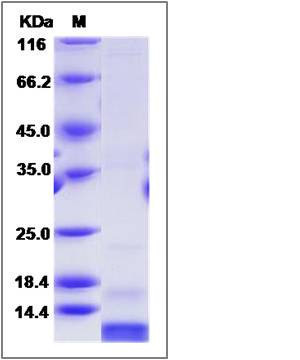Mouse S100A4 Protein
18A2,42a,Capl,FSp1,metastasin,Mts1,PeL98,pk9a
- 100ug (NPP3464) Please inquiry
| Catalog Number | P50484-MNCH |
|---|---|
| Organism Species | Mouse |
| Host | Human Cells |
| Synonyms | 18A2,42a,Capl,FSp1,metastasin,Mts1,PeL98,pk9a |
| Molecular Weight | The recombinant mouse S100A4 consists of 102 amino acids and predicts a molecular mass of 11.7 KDa. It migrates as an approximately 12 KDa band in SDS-PAGE under reducing conditions. |
| predicted N | Gly |
| SDS-PAGE |  |
| Purity | > 85 % as determined by SDS-PAGE |
| Protein Construction | A DNA sequence encoding the mouse S100A4 (P07091)(Ala2-Lys101) was expressed and purified with two additional amino acids (Gly & Pro) at the N-terminus. |
| Bio-activity | |
| Research Area | Signaling |Signal Transduction |Signaling Pathway |Calcium Signaling |Calcium Binding Proteins |
| Formulation | Lyophilized from sterile PBS, pH 7.4. 1. Normally 5 % - 8 % trehalose and mannitol are added as protectants before lyophilization. Specific concentrations are included in the hardcopy of COA. |
| Background | S100A4, also known as metastasis-associated protein Mtsl, belongs to the family of small calcium-binding S100 proteins containing two EF-hand calcium-binding motifs. In humans at least 20 S100 family members that are distributed tissue specifically have been identified, and are involved in a number of cellular processes as transducers of calcium signal. S100A4 is a symmetric homodimer, and undergoes a relatively large conformational change upon the typical EF-hand binding calcium, which is necessary for S100A4 to interact with its protein targets and generate biological effects. It can bind the already known targets p53, F-actin, liprin β, myosin heavy chain II, and prevent their phosphorylation and multimerization. It has been demonstrated that S100A4 is directly involved in tumor metastasis including cell motility, invasion, apoptosis, angiogenesis and differentiation, and appears to be a metastasis factor and a molecular marker for clinical prognosis. Multiple alternatively spliced variants encoding the same protein have been identified. |
| Reference |
